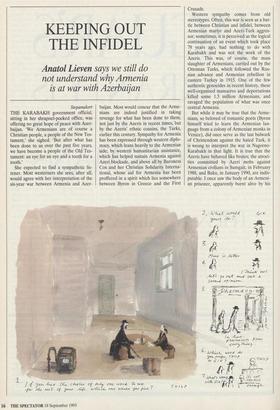KEEPING OUT THE INFIDEL
Anatol Lieven says we still do
not understand why Armenia is at war with Azerbaijan
Stepanakert THE KARABAKH government official, sitting in her shrapnel-pocked office, was offering no great hope of peace with Azer- baijan. 'We Armenians are of course a Christian people, a people of the New Tes- tament,' she sighed. 'But after what has been done to us over the past five years, we have become a people of the Old Tes- tament: an eye for an eye and a tooth for a tooth.'
She expected to find a sympathetic lis- tener. Most westerners she sees, after all, would agree with her interpretation of the six-year war between Armenia and Azer- baijan. Most would concur that the Arme- nians are indeed justified in taking revenge for what has been done to them, not just by the Azeris in recent times, but by the Azeris' ethnic cousins, the Turks, earlier this century. Sympathy for Armenia has been expressed through western diplo- macy, which leans heavily to the Armenian side; by western humanitarian assistance, which has helped sustain Armenia against Azeri blockade, and above all by Baroness Cox and her Christian Solidarity Interna- tional, whose aid for Armenia has been proffered in a spirit which lies somewhere between Byron in Greece and the First Crusade.
Western sympathy comes from old stereotypes. Often, this war is seen as a bat- tle between Christian and infidel, between Armenian martyr and Azeri-Turk aggres- sor; sometimes, it is perceived as the logical continuation of an event which took place 78 years ago, had nothing to do with Karabakh and was not the work of the Azeris. This was, of course, the mass slaughter of Armenians, carried out by the Ottoman Turks, which followed the Rus- sian advance and Armenian rebellion in eastern Turkey in 1915. One of the few authentic genocides in recent history, these well-organised massacres and deportations killed some 1.5 million Armenians, and ravaged the population of what was once central Armenia.
But while it may be true that the Arme- nians, so beloved of romantic poets (Byron himself tried to learn the Armenian lan- guage from a colony of Armenian monks in Venice), did once serve as the last bulwark of Christendom against the hated Turk, it is wrong to interpret the war in Nagorno- Karabakh in that light. It is true that the Azeris have behaved like brutes; the atroci- ties committed by Azeri mobs against Armenian civilians in Sumgait, in February 1988, and Baku, in January 1990, are indis- putable. I once saw the body of an Armeni- an prisoner, apparently burnt alive by his Azeri captors. I have also seen an Armeni- an soldier's heart, cut out of its body, placed in a jamjar on an Azeri soldier's grave. The jar was placed there by the dead Azeri's mother; still, it is appalling that no other Azeri had the common decency to take the horrible object away and bury it.
But I also saw, in March of last year, the bodies of several dozen Azeri civilians from the captured town of Hojali, slaugh- tered and sometimes mutilated by Armeni- ans. These mutilations admittedly show encouraging signs of western cultural influ- ence: several of the bodies had been scalped. Since this is not a local tradition, one must presume that those responsible learned it from American films.
Atrocities always occur during wartime, however, so perhaps it is worth looking more closely at the moral claims of both sides. This war began as a territorial dis- pute over borders drawn by Stalin in the 1920s. The centre of the dispute is Nagorno-Karabakh, an enclave of Azerbai- jan which contains a majority of Armeni- ans. These Armenians tried, six years ago, to secede. From the start, most outsiders assumed that they were fighting a lost cause: because of what happened in 1915 and after, the Armenians were believed to be helpless victims while the Azeris, a peo- ple closely related to the Turks, were thought to share in Turkish martial valour and toughness. Frankly, when the war began, I didn't think the Armenians had a chance.
But the Azeris are very far from being Turkish Turks. To start with, the Azeri army is one of the worst rabbles I have ever seen. Last year they lost Shusha, a perfect natural fortress, mainly because they were too lazy and undisciplined to post guards at the top of the cliffs. The front-line troops remain badly armed and few, while far greater numbers of troops, and all the senior officers, are safely man- ning headquarters and road-blocks far to the rear. Several Azeri generals have been arrested for trading with the enemy, and no Azeri I have met finds their guilt implausible. Alexis Rowell, the BBC corre- spondent in the Caucasus, once raised his glass to the best Azeri sturgeon he had ever eaten — in a mafia-run restaurant in the Armenian capital, Yerevan. For many Azeris, the rhetoric of national struggle does not seem to mean much more than the old Soviet rhetoric did. With the num- ber of volunteers shrinking quickly, and the conscription system in chaos, the Azeri authorities have been reduced to press- ganging young men arrested for violating the curfew into the army.
The Armenians, on the other hand, have proved excellent soldiers, although it is often said that they have achieved their victories with the help of Russian soldiers and guns. This alleged Russian interfer- ence is hard to pin down — Russian mer- cenaries are fighting on both sides, and I have myself ridden in an Azeri attack heli- copter flown by a Russian pilot— but it true that during the decades of Soviet rule, Armenian conscripts were posted to Soviet combat units, whereas the Muslim Azeris, distrusted by Moscow, were usually pushed into non-combatant labour battal- ions. The Armenians therefore accumulat- ed far more military experience, and maintain better connections with their old comrades: the Karabakh Armenians like to boast that they provided a higher num- ber of Soviet generals than any other region of the former Union.
The Armenians are also a far more committed lot — precisely because of the memory of the genocide, drilled into every Armenian child from an early age. Of all the Armenians, no group are more hard- bitten than those of Karabakh; indeed I have rarely seen a people more evocative of the Old Testament spirit. All of this adds up to military imbalance, in favour of Armenia: the Armenians are now so con- temptuous of Azeri soldiers that they park tanks and armoured vehicles in clear view of Azeri positions, confident that the Azeris could not hit them if they tried.
But the question of who is morally right goes beyond national stereotypes, and there is evidence which shows that the sense of righteous revenge among Karabakh Armenians is unjustified. It is worth noting that the first blood in the present conflict was actually Azeri blood, shed by the Karabakh Armenians in a riot in February 1988, during which two local Azeris were killed. The attack on Armeni- ans in Sumgait two days later was probably spearheaded by Azeris who had already been driven out of their homes in Nagorno-Karabakh. It is also true that Armenian pressure on Azeri minorities, both in Karabakh and in Armenia proper, had begun well before Sumgait. In the months that followed, Armenians poured out of Azerbaijan— while the entire Azeri population of Arme- nia, more than 200,000 strong, was driven out in an officially orchestrated campaign. When Lady Cox writes of 'ethnic cleansing in progress' as if it applied only to the Azeris, she is only giving one side of the picture.
Before the war, Karabakh was in fact an ethnically mixed area, with a large Azeri minority (about 30 per cent). This was a historic Turkic population, present in the area for some 900 years and possessing, in Shusha, an old Azeri cultural centre. In these circumstances, the notion that Arme- nians in Karabakh have absolute prece- dence on grounds of original occupancy is much like the notion that the Protestants of Northern Ireland must give way to the Catholic descendants of the Gaelic Irish because their ancestors were there first.
According to an Armenian émigré schol- ar, George A. Bournoutian, the Armeni- ans were themselves a minority in what is now the Republic of Armenia until the late 19th century. During the past 170 years, however, Armenians have left Muslim- controlled areas for territories under Rus- sian or Soviet imperial control, while Muslims have moved in the opposite direc- tion — a process which has left much bit- terness and many complications behind. The vagaries of war and Soviet policy left the whole area looking like a multi- coloured ethnic jigsaw puzzle: the borders are Turkish, Armenian, Azeri, Armenian, then Azeri again, criss-crossed by numer- ous individual villages, little islands of the Armenian or Azeri republics, entirely sur- rounded by the other republic's territory.
None of this is to say that the Azeris are therefore 'right' and the Armenians 'wrong'. In any case, this is a war now, not a border dispute, and it is clear that the Armenians are going to win it. This sum- mer, Armenians, in a series of successful offensives, have conquered large areas of Azerbaijan proper; in the past three weeks alone, some 200,000 Azeri refugees have fled from their homes. In consequence, the new ruler of Azerbaijan, a former commu- nist leader called Heidar Aliev, has agreed to negotiate directly with the Karabakh Armenians for the first time.
A peace settlement for the conflict, which has cost up to 15,000 lives, at last seems possible. For this to happen, howev- er, it would help if the West would put pressure on the Karabakh Armenians to give up most of the Azeri land they have conquered, and perhaps accept some kind of theoretical Azeri sovereignty. This seems unlikely: rather surprisingly, the western press has continued, right through this summer, to portray the Armenians as the innocent victims. In some cases, influ- ential articles and even books on the con- flict were written by westerners who had never visited Azerbaijan at all. The Azeris may not be very admirable people, but they deserve fairer treatment than this.




































































 Previous page
Previous page